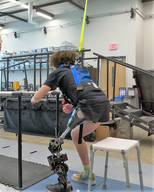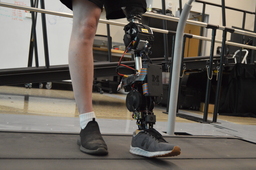Data-Driven Variable Impedance Control of a Powered Knee-Ankle Prosthesis for Variable Activities
TECHNOLOGY NUMBER: 2023-252


OVERVIEW
Open-source prosthesis controller enables intuitive sitting, standing, and walking transitions.
- Improves gait quality, ease of use, and adaptability over traditional finite state machines
- Supports prosthetic research, device development, and integration in complex control systems
BACKGROUND
This software package contains a simplified version of our prosthesis controller for sitting, standing, and walking which has been compiled to run on the Open Source Leg. The controller allows a user to sit, stand, and walk across level ground, and it automatically handles switching between walking and sit/stand modes. We provide an example starter script, allowing anyone with an Open Source Leg to run our controller with minimal upfront effort. We also provide the code to calculate our walking phase variable on its own, allowing it to be integrated into other controllers and applications.
It is our hope that this software release helps accelerate the field's research in the control of robotic leg prostheses. Potential uses of this software release include but are not limited to: 1) using our controller as a comparison point for a novel walking controller, 2) using our controller as a component in a larger, more complex controller, 3) using our controller when researching other related topics, such as balance or metabolic cost.
INNOVATION
Many impedance controllers for robotic leg prostheses utilize discrete, heuristically-tuned parameters and finite state machines to achieve desired locomotion behaviors. These finite state machine approaches can be lengthy to tune and can result in jerky, robotic-looking gaits if tuned inappropriately. Despite these drawbacks, they are still broadly used in both academic research and commercial products due to their simplicity and relative ease of implementation.
To mitigate the drawbacks of finite state machine controllers, our lab has pioneered a new approach utilizing a phase variable and continuous impedance parameter functions in lieu of a finite state machine. We use convex optimization to automatically identify optimal impedance parameter functions, resulting in biomimetic joint kinematics and kinetics without manual tuning. Our controller works out-of-the-box for a novel user, requiring only their weight in terms of configuration and is thus even easier to implement than most finite state machine controllers. In addition to joint position sensors, it only requires sensor measurements of ground contact and the global orientation of the thigh segment. We have demonstrated our new approach's efficacy for walking over various speeds and inclines, stair ascent and descent, and sit/stand motions.
ADDITIONAL INFORMATION
REFERENCES:
T. K. Best, C. G. Welker, E. J. Rouse and R. D. Gregg, "Data-Driven Variable Impedance Control of a Powered Knee–Ankle Prosthesis for Adaptive Speed and Incline Walking," in IEEE Transactions on Robotics, vol. 39, no. 3, pp. 2151-2169, June 2023, doi: 10.1109/TRO.2022.3226887
C. G. Welker, T. K. Best and R. D. Gregg, "Improving Sit/Stand Loading Symmetry and Timing Through Unified Variable Impedance Control of a Powered Knee-Ankle Prosthesis," in IEEE Transactions on Neural Systems and Rehabilitation Engineering, doi: 10.1109/TNSRE.2023.3320692
LAB WEBSITE: Locomotor Control Systems Laboratory
-
expand_more mode_edit Inventor (4)Robert GreggRoss CortinoCara WelkerKevin Best
-
expand_more cloud_download Supporting documents (1)Product brochureData-Driven Variable Impedance Control of a Powered Knee-Ankle Prosthesis for Variable Activities.pdfAdditional files may be available once you've completed the transaction for this product. If you've already done so, please log into your account and visit My account / Downloads section to view them.